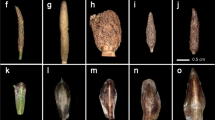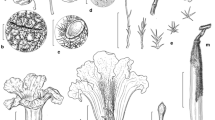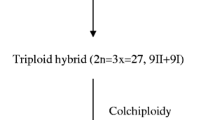Abstract
Diploid (2n = 36) plants ofEpilobium latifolium L. have been found in Alaska and the western Cordillera of North America, and tetraploids in Iceland, western Greenland, and southeastern Quebec. Study of the morphology of these chromosome races revealed a character, the number of pores in the pollen grains, by which they could be distinguished with an average probability of 75%. Tetraploids ofE. latifolium tend to have high percentages of 4-pored pollen, while the diploids usually have only 3-pored pollen. On this basis, the ranges of the races were extrapolated from herbarium material. Detailed comparisons of eight other features of the presumptive diploids and tetraploids showed no significant difference between them. The races appear to form worldwide, allopatric, ecogeographic phases. A high level (57.4%) of quadrivalent formation observed during tetraploid meiosis, and other considerations, indicate that the tetraploids arose by autopolyploidy. The recommendation is made that the races not be given formal taxonomic recognition.
Similar content being viewed by others
Literature Cited
Böcher, T. W. 1962. A cytological and morphological study of the species hybridChamaenerion angustifolium X C. latifolium. Bot. Tidssk.58: 1–34.
Davis, P. H. &V. H. Heywood. 1965. Principles of Angiosperm Taxonomy. London: Oliver & Boyd. xvi + 558 pp. (Second printing.)
Grant, V. 1957. The plant species in theory and practice. pp. 39–80.In: Mayr, E. (Editor). The Species Problem. Publ. 50, A.A.A.S., Washington, D. C.
Haussknecht, C. 1884. Monographie der GattungEpilobium. Jena. viii + 318 pp.
Hecht, A. 1942. Colchicine-induced tetraploidy inOenothera. Proc. Indiana Acad. Sci.51: 87–93.
Klein, W. M. 1964. A biosystematic study of four species ofOenothera subgenusAnogra. Thesis: Ph.D. Claremont Graduate School, Claremont, California. vi + 191 pp.
Knuth, P. 1908. Handbook of Flower Pollination. Vol. 2. Oxford, England: Clarendon Press. viii + 703 pp. (Translated by J. R. Ainsworth Davis.)
Kurabayashi, M., H. Lewis, &P. H. Raven. 1962. A comparative study of mitosis in the Onagraceae. Amer. Jour. Bot.49: 1003–1026.
Löve, A. &Doris Löve. 1949. The geobotanical significance of polyploidy. I. Polyploidy and latitude. Portugaliae Acta Biol. Ser. A. (R. B. Goldschmidt Vol.)1949: 273–352.
—. 1961. Chromosome numbers of Central and Northwest European plant species. Opera Bot.5: 1–581.
Mayr, E. 1963. Animal Species and Evolution. Cambridge, Massachusetts: Belknap Press. xiv + 797 pp.
Michaelis, P. 1926. über den Einfluss der KÄlte auf die Reduktionsteilung vonEpilobium Planta1: 569–582.
—. 1954. Cytoplasmic inheritance inEpilobium and its theoretical significance. Advances in Genetics6: 287–401.
Mosquin, T. 1966a. A new taxonomy forEpilobium angustifolium L. (Onagraceae). Brittonia18: 167–188.
—. 1966b. Toward a more useful taxonomy for chromosomal races. Brittonia18: 203–214.
-. 1967. Evidence for autopolyploidy inEpilobium angustifolium L. (Onagraceae). Evolution (In press.)
—. 1966. Chromosome numbers and taxonomy of some Canadian arctic plants. Canadian Jour. Bot.44: 1209–1218.
Munz, P. A. 1965. Onagraceae.In: North Amer. Flora II. Part5: 1–231.
Pugsley, H. C. 1960. Interesting hybrid willow-herbs. Bull. Hardy Plant Soc.2(5): 102–104.
Raven, P. H. 1962. The genusEpilobium in the Himalayan region. Bull. British Mus. (Nat. Hist.) Bot.2(12): 325–382.
Small, E. 1966. Chromosomal and morphological variation inEpilobium latifolium L. Master’s Thesis: Carleton University, Ottawa, Ontario, Canada. xi + 75 pp.
Vasek, F. C. 1956. Induced aneuploidy inClarkia unguiculata (Onagraceae). Amer. Jour. Bot.43: 366–371.
Author information
Authors and Affiliations
Additional information
Based in part on a thesis submitted as partial requirement for the degree of Master of Science in Biology, Carleton University, Ottawa, Canada.
Rights and permissions
About this article
Cite this article
Small, E. The systematics of autopolyploidy in Epilobium latifolium (Onagraceae). Brittonia 20, 169–181 (1968). https://doi.org/10.2307/2805620
Issue Date:
DOI: https://doi.org/10.2307/2805620




